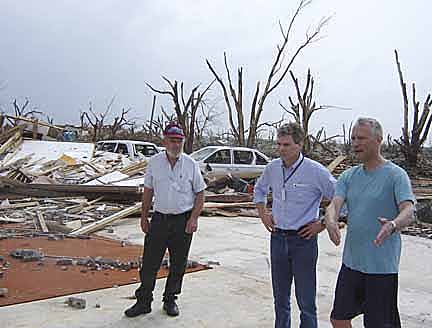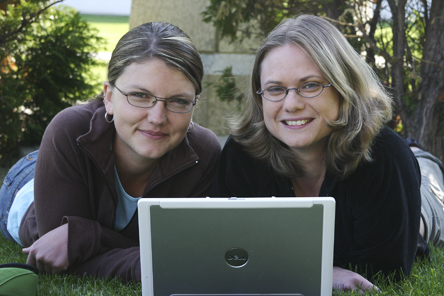Canadian Mennonite
Volume 11, No. 11
May 28, 2007

MDS on scene of Kansas tornadoes within hours
Greensburg, Kan.
 |
A series of at least six tornadoes tore through southwestern Kansas on the evening of May 4, wiping out more than 90 percent of homes in the town of Greensburg alone. As of press time, the death toll stood at 12.
Within hours, four teams from the Kansas unit of Mennonite Disaster Service (MDS) were in the area doing clean-up.
Rev. Jeff Blackburn, pastor of Greensburg Mennonite Church, said, “I’m trained and do trauma work…” but was unable to finish his sentence. The church Blackburn has pastored for 11 years is completely gone, and the building where he and, his wife and their 17-year-old daughter were in was completely blown away as well.
Kevin King, executive director of MDS, was on the scene the next day. “It’s like something I haven’t seen before,” he said. “It looks like a giant rake came through and raked the town away.” King was emotional as he described that there didn’t seem to be any walls remaining standing in the town. “Virtually, not even a cluster of bricks left.”
Greensburg has a population of 1,500. Blackburn said that three-quarters of his 80 or so congregants live in town, and now at least three dozen of them are without homes.
Although their church building is gone, Blackburn said they have put up notices that they still planned on having a service Sunday morning, even if it would be in the high school parking lot in nearby Haviland.
Many of the people who were evacuated from Greensburg have been given shelter and food in Haviland, where the Red Cross has set up operations in the local high school gym.
Aside from initial clean-up operations, MDS volunteers will work on roof damage of those houses that are still standing, as well as help congregants of the Greensburg church sort through their personal effects.
MDS was started in 1950 as a Mennonite Sunday school’s response to tornadoes that had hit Kansas.
A note from cyberspace:
Online Christians go from Facebook to face-to-face
 |
The question is no longer whether younger generations in the church are connecting online, but rather how they are connecting online. A vast array of websites facilitates discussion on all manner of topics. Weblogs (blogs) are sites that allow users to post information and opinions chronologically. Other sites—like MySpace and Facebook—advertise themselves as social networking tools and allow users to browse each other’s profiles, post messages and join groups of common interest.
Online networking is not a new phenomenon. What is new, though, is that organizations and institutions are becoming aware that their students or employees are part of online communities.
Canadian Mennonite University (CMU) Student Life staffer Cordella Friesen recently became intrigued by the online student activity and the sense of connectedness that it offers individuals who might otherwise feel disenfranchised. Should congregations be aware that their youths and young adults are most likely active online? “Definitely,” says Friesen, since online communities can be incorporated into church approaches to mentoring, lessons on accountability, and conversations about the meaning of community.
At its worst, online community and the sometimes addictive invisibility it offers, can be a vehicle for destructive ranting that can cost people their reputation or job. And as with any human social network, it can also be a source of conflict. Because of the “connected disconnectedness” that the Internet offers, users may be less careful with potentially damaging words.
Online users can also be choosy of those they mingle with. This feature has pros and cons. Allan Reesor-McDowell, Mennonite Central Committee Ontario youth and young adult coordinator, says that in true community we do not have the luxury of choosing our companions. However, he points out that the majority of today’s young adults are connected to several communities and make use of online networking for that reason.
Reesor-McDowell has a “web” of relationships in his family, church, high school, work and university, and from many towns, cities and countries that he has connected with in his 25 years. “I am now online connecting with many of these communities to network with and learn from inspirational, passionate and creative young adults thinking about what it means to be part of the body of Christ today,” he says, adding, “Online community is great if it is one of a number of communities that I am a part of and as long as it does not take away from the relationships with the people I am with day-to-day.”
At its best, online networking connects people in ways that have never previously been possible. Steven Kriss of Franconia Mennonite Conference in the U.S. tells the story of a young Indonesian man who has lived in the States for 12 years and is part of a primarily Indonesian MC USA congregation, but who just started making broader Mennonite community connections using Facebook.
“When his friend, who is not Mennonite,… was gravely injured in a car accident in Washington [D.C.], he used the Mennonite networks at his disposal to find pastoral care and text-messaged me about the incident, asking for prayer. I then contacted a chaplain at a nearby hospital to help provide pastoral care for the family,” says Kriss.
In the past, new methods of social networking—like the telephone and e-mail—radically altered workplaces and the way communication was understood. Cyber-networking—like these other methods of communication—brings challenges together with the new possibilities.
Friesen believes that the direction an online community takes can be determined by the person administering the site. Asking the right questions can focus a discussion in a direction that leads toward positive thoughts and actions.
There are a number of faith-related websites that have constructively directed conversations (like young.anabaptistradicals.org). These sites can act as a space for people on the margins, where they can explore questions of faith and connect with others who are geographically distant but share similar values and ideas.
Ultimately, the best that cyber-community can do is to connect people in real life. Gatherings like this year’s Mennonite Church Canada assembly offer intergenerational opportunities for discussion and learning. Young adults often mention a yearning for community meaning and this is only satisfied through face-to-face meetings with real people who challenge us, provide accountability, and grow together with us.
Online community is not a substitute for real-life interaction, but it is an extension of our networks. And it opens up new global church opportunities, while offering a way to continue discussions across the physical miles.
‘Emergent conversation’ attracts Mennonites
Philadelphia, Pa.
When participants gathered in suburban Philadelphia for the 2007 Emergent Conversation, they were surprised at how many Mennonites were a part of the group.
Nearly 150 people joined the conversation—including Mennonite Church Canada staffers Hinke Loewen-Rudgers and Al Rempel—held from April 16 to 18 on the campus of Eastern University and at a nearby church.
Coordinated by Emergent Village, the event was referred to as a “conversation,” as opposed to a conference, as a way to set an informal tone and invite participation from all levels. On its website, Emergent Village describes itself as “a growing, generative friendship among missional Christians seeking to love our world in the Spirit of Jesus Christ.”
Loewen-Rudgers of Winnipeg was a first-time participant who found the time to be both interesting and educational. “It’s important for Mennonites to be in conversation [about] what it means to be Mennonite and Christian in our world today,” said Loewen-Rudgers, who works with MC Canada. “It’s only in conversation and engagement with others that our own faith journey really makes a difference to the local and global community.”
Jess Walter, who works with Franconia Mennonite Conference in the U.S., agreed. “If we are going to be missional Christians, our churches are going to be constantly emerging, constantly in the process of new formation and rethinking,” she said. Walter hopes that building relationships with others who are Anabaptist-oriented might help the Mennonite Church learn more about itself. “Welcoming those outside of our heritage who align with our theology can help us to learn what is theology and what is ethnic about who we are as Mennonites, and teach us about the unintentional walls our culture has created.”
Mark Van Steenwyk of Minneapolis, Minn., who came representing emerging Mennonite congregations, counts himself among a growing number of young Anabaptists who are anxious to both live and proclaim the gospel of Jesus. “We want a Christianity centred around the Sermon on the Mount,” he said. “The Mennonite Church has generations of thought, dialogue and action that I desperately want to explore.”
“On the other hand,” he added, “I’d like to think that folks like me have something to contribute, as well. We have creative ways of thinking about…mission—ways of embodying an Anabaptist ethic—that resonate with our emerging culture.”